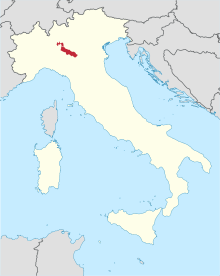Roman Catholic Diocese of Cremona
| Diocese of Cremona Dioecesis Cremonensis | |
|---|---|
|
| |
| Location | |
| Country | Italy |
| Ecclesiastical province | Milan |
| Statistics | |
| Area | 1,917 km2 (740 sq mi) |
| Population - Total - Catholics |
(as of 2013) 368,797 331,250 (est.) (89.8%) |
| Parishes | 224 |
| Information | |
| Denomination | Catholic Church |
| Rite | Roman Rite |
| Established | 4th century |
| Cathedral | Cattedrale di S. Maria Assunta |
| Secular priests |
308 (diocesan) 28 (Religious Orders) |
| Current leadership | |
| Pope | Francis |
| Bishop | Antonio Napolioni |
| Emeritus Bishops | Dante Lafranconi |
| Map | |
 | |
| Website | |
| www.diocesidicremona.it | |
The Diocese of Cremona (Latin: Dioecesis Cremonensis) is a Roman Catholic ecclesiastical territory in northern Italy, a suffragan of the Archdiocese of Milan.[1][2] Its see is the Cremona Cathedral.
History
Cremona is in Lombardy, Italy, on the left bank of the River Po. It was built by the Cenomanni Gauls, but later became a Roman colony and a frontier fortress.
About 600 Cremona, until then a part of the Byzantine Emperor, was captured by the Lombard king, Agilulf. Under the Emperor Otto I and his successors, its bishops acquired temporal sovereignty, but in 900 the people expelled Bishop Olderico and adopted a republican form of government.
The Emperor Henry IV (1056–1106), however, confirmed Bishop Landulf in all imperial grants made to his predecessors. On the other hand Emperor Henry V (1106–25) restored to the people their communal rights. Thenceforth Cremona became a citadel of Ghibellinism and was greatly favoured by Frederic Barbarossa and Emperor Frederick II, though for the same reason frequently at war with the neighbouring cities. In later medieval times it had many lords or "tyrants", the Pallavicini, the Bovara, the Cavalcabo, the Visconti, the Sforza, until it became part of the Duchy of Milan (1328). In 1702 it was taken by imperial troops, and in 1796 and 1800 fell into the hands of the French.
The people of Cremona venerate St. Sabinus as their first missionary and first bishop; he is said to have lived in the 1st century of our era. Among the better-known early bishops are St. Syrinus (c. 340), a valiant apologist of the Faith against the Arians, and St. Silvinus (733); the latter is held in great veneration. Liudprand of Cremona was sent (946) as ambassador to Constantinople by the Emperor Otto II, and is the most famous historical writer of the 10th century.
Other important bishops were Gualtiero (1096), in whose time the cathedral was begun; Sicardo (1185), author of a chronicle; Cacciaconte da Somma (1261), under whom was erected the belfry of the cathedral; Niccolo Sfondrati (1560), later Pope Gregory XIV; his nephew Paolo (1607); also the zealous and charitable Omobono di Offredi (1791).
Parishes
The diocese has 223 parishes, all located within the region of Lombardy. The great majority (174) of these fall within the Province of Cremona. There are 28 in the Province of Mantua, 17 in the Province of Bergamo, and 4 in the Province of Milan.[3]
Notes
- ↑ "Diocese of Cremona" Catholic-Hierarchy.org. David M. Cheney. Retrieved February 29, 2016
- ↑ "Diocese of Cremona" GCatholic.org. Gabriel Chow. Retrieved February 29, 2016
- ↑ Source for parishes: CCI (2008), Parrocchie, Chiesa Cattolica Italiana, retrieved 2008-03-15.
External links
![]() This article incorporates text from a publication now in the public domain: Herbermann, Charles, ed. (1913). "article name needed". Catholic Encyclopedia. New York: Robert Appleton.
This article incorporates text from a publication now in the public domain: Herbermann, Charles, ed. (1913). "article name needed". Catholic Encyclopedia. New York: Robert Appleton.
Coordinates: 45°08′00″N 10°02′00″E / 45.1333°N 10.0333°E
